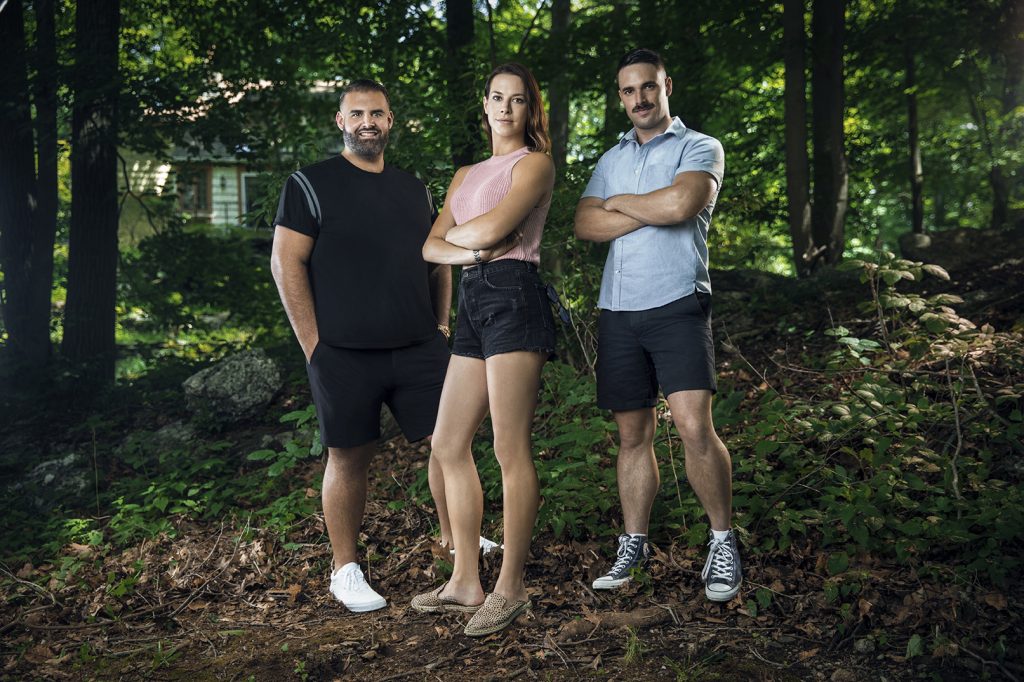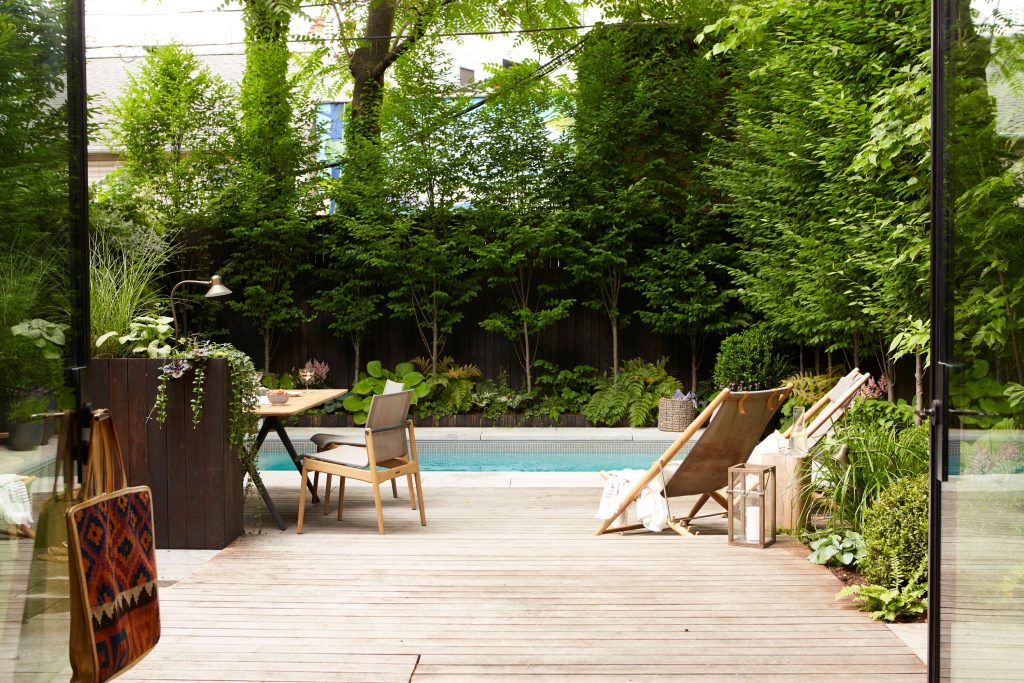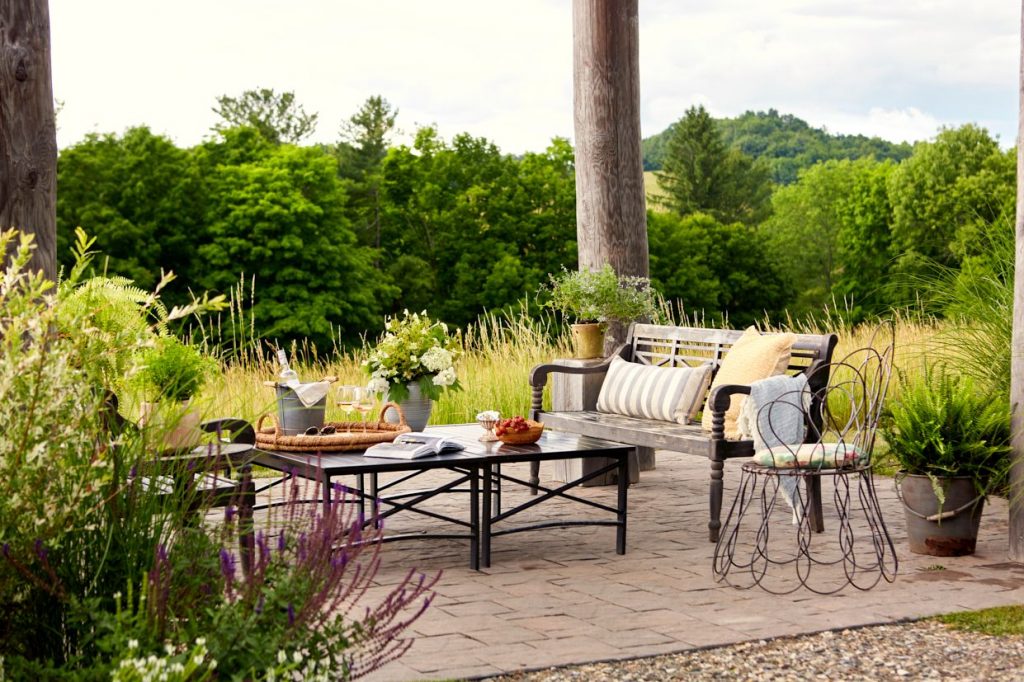Interview: Exterior Design Trio, Manscapers
Around NYC, LA and Miami, a talented team assembles verdant oases and floral dreamscapes

To have stepped into an event designed by the Manscapers—Garrett Magee, James DeSantis and Mel Brasier—as we did in 2019, meant entering a living vision of the potential for plants. But the trio does more than assemble the occasional spectacle (all of which are on pause anyway, due to the pandemic); they piece together private clients’ personal outdoor escapes. Their full-service boutique design firm helps to conceptualize, source and populate dreamscapes, regardless of how large or small. From partnerships with the New York Botanical Garden, where they were the creative directors of last year’s NYBG annual antique fair and later partners with Jeff Leatham for this year’s NYBG Orchid Dinner, to their own BravoTV program (BackYard Envy), the Manscapers continue to blossom in a traditionally staid industry. We spoke with all three via email to gauge where the business is right now, how to work with smaller spaces and what it means to be different in the world of landscaping (a word that scarcely touches upon what they do).

Can you tell us a bit about your origin story? How you got into this and how you got educated on it?
James DeSantis: We all have varied backgrounds in design—Mel and I went to interior design school together at FIT, where we learned all of our technical and interdisciplinary skills of design which we implement to this day. Garrett grew up landscaping in his younger years with his family, and has an art and design background as a graphic designer and editor. We started the business really as an exterior design firm—taking our principles of interior design and allocating them to the realm of small outdoor spaces in NYC. I think that’s why our work has such a specific look, because we’ve always taken an approach of creating livable spaces outdoors. Our plant and technical knowledge pertaining to landscape architecture comes from botanical garden classes—we still have a successful partnership with the New York Botanical Garden now, working with them for the past two years on collaborations and partnerships—and of course in-the-field training.

Perhaps more than ever, horticulture acts an escape. What would you say to New Yorkers with little to no space? And who are afraid of failing?
Starting with a concept is always your best bet—even if your space is tiny. Come up with what you want the space to look like in the end, and then work backwards. It’s an easier way to not fail, if you have a clear plan. If your space is very tiny, implementing one or two statement plants is always a better option than adding a lot of many small pots.

You also work in LA. How is it different?
The luxury of Los Angeles is more space, obviously! Which sometimes can be even harder to design for. Keep it simple, with a concept and a uniform planting palette. The options are more varied in LA for planting and style, ie: drought-tolerant and desert, or more formal boxwood and roses, tropical works well also—and everything grows like crazy. So make sure you know your level of maintenance you’re willing to put in (or lack thereof) and research a lot about water and how much is necessary for your planting.
The overall goal we all have is the same: to bring beauty and green and outdoor sanctuaries
For people who do not know, what is the New York exterior design and landscape market like?
It’s actually a very undersaturated market, unlike interior design, which is one of the reasons we started our business. It’s such a hard place to implement designs—from the traffic, to the shipping, to the elevators and cranes, co-ops and condos, and rentals etc. The obstacles are never-ending, which makes it hard to find a good designer and contractor from a pool of trades that is already very small! We have a few designers and firms we love that we always cross-promote, and it’s really just positive because we all want to green up this concrete city—so there’s really no competition at all—we have our niche, they have theirs. And once we got a TV show about it, it’s been nothing but love from those businesses as well. The overall goal we all have is the same: to bring beauty and green and outdoor sanctuaries to our clients.

When you take on a new client, how do you begin the process of bringing a verdant oasis to life?
First of all, love a “verdant oasis!” We always like to see a client’s interior style and taste first—we’re not going to install an English garden for someone who has a laidback, worldly style. We also stalk their social media, take their personal fashion style into consideration and we do an informal interview. What is the space going to be used for, do you have kids, are you an entertainer, do you read and relax outside by yourself, etc. All of this goes into our style repertoire and design elements we employ and we create a plan from there.

Where do you all look for inspiration? What is R&D like for new plants?
We find inspiration all over—like we mentioned, NYBG is a huge inspiration point for us; Brooklyn Botanical Garden, too. Traveling is a huge inspiration. (We miss that.) Fire Island is a huge inspiration point for us. In LA, we love Huntington Gardens, Flamingo Estate, Dawnridge Gardens.

I’m curious how you describe what you do for and with clients.
We always describe that we are an exterior design firm and live installation artists. We don’t describe ourselves as landscape designers or architects—even though that’s a lot of what we do.
We really always harken back to the fact that we bring the indoors outside, and vice versa. We take your interior style, design requirements and lifestyle into account and bring those outdoor for your exterior space, and when we install living events we take the outside world, the world of plants and foliage and bring it into an interior or “contained” atmosphere for events.

Has COVID impacted your business, work, and the needs of clients?
At first it was devastating, much like every industry, but we luckily got approval to go back to work early on, and a lot of our clients are very comfortable with our work because it’s outdoors, and we are very safe. The way COVID has changed our work is the need from all clients to employ so many different types of uses for their already small spaces. Now everyone wants a Zoom background, a place for the kids to play (and e-learn), an outdoor gym, a breakfast, lunch and dinner nook, and the list goes on and on. Lucky for us, everyone is very invested in putting money into their spaces because they really do, as do we, recognize that the world is now changed and the home is a safe space that we should continue to invest in.

You’ve definitely become the face of gardening and exterior design, for a new, younger generation of gardeners. How did this come about, and how would you describe this community you’re at the forefront of?
We always say, “We’re not your grandma’s gardeners!” And it’s something we really are proud of and love to keep pushing forward with our brand and company. We love and respect and look up to and are inspired by many of the architects and gardeners that have come before us, but there can be a stuffy element to this industry. We see that there is this millennial explosion and interest in gardening and plants and we’d love to keep that interest (I almost said trend, but it’s not a trend!) going forever.
We’re not sure if we can describe what this community is because it’s still so new, but we would say we consider ourselves to be a millennial-run firm, and our focus and attention and clients are really for that millennial and now soon to be Gen-Z (dare I say it!) homeowner, and follower. We’re in the beginnings of an online and brick-and-mortar store opening which we think will be a great place to move and promote rare plants, and young people getting their interest in plants and gardening going.
How has Backyard Envy helped further your business? Do you feel like it conveys what you do?
The show is an eight-hour commercial every year for us. We love doing it. Also, it’s fun to show your weird life and work, that is so unique, on TV. This season’s a little more drama-filled so that’s been interesting, but it always helps with work. It also allows us to be more picky and to choose who and what we want to do, which is always a great feeling.
As you’re a team comprised of a women and two gay men, what is it like working in exterior design (and aspects such as construction, etc.) that are predominately perceived as “masculine.” And what is it like to do so on television?

That aspect can be difficult. We’ve all always had a difficult time with this “masculine” industry by being treated a certain way by vendors, nurseries, builders and trades. We definitely get this like, “Oh, here we go—the Manscapers are here” sort of attitude, but we shrug it off.
Our company is 90% gay men that work for us, and is a woman- and gay men-run company and our work is beautiful because of that. We get questioned a lot on our decision-making and capabilities because of this, but we know we’re the ones that are being hired to implement our taste and ideas.
Can you tell me a bit about the outdoor candles and bug-repellant you have in the pipeline?
We’ve got a lot in the pipeline as far as merchandise and future endeavors. We’ve trademarked and developed a whole line of items that take “the inside out”—unique items that you would use in your interior applied to exterior uses. For example, a large candle that repels bugs (but isn’t citronella) that you can bring inside in the winter and take outside in the summer. Outdoor blankets and towels that use fabrics that dry and can withstand the sun.
Garden boots and gloves that are actually chic. Little tweaks that we know our market and following would get excited about. All of this will go in our soon-to-be online and brick-and-mortar store. Our book, which is a guide to exterior design, will follow this same ethos, and be within the same lifestyle brand and sold together.

Finally, do you have dream plants that you love to incorporate? And dream plants you hope to one day incorporate?
Oh, this is too tough of a question to answer! We always unintentionally have a plant of the year. Each year, we sort of shift focus onto a new obsession and it goes into every garden, every interview, our show. Last year it was smoke bushes. In LA this year it’s Palo Verde. The first year we started this business it was a Japanese maple. Garrett always loves a take on interesting pines—like a Thunderhead Pine or a Mugo Pine. We always loved LA and Miami plants and plantings for those zones, and now we have offices in LA and a satellite in Miami taking on a lot of projects—so we get our warm weather plant picks when it’s freezing in NYC.
Hero image courtesy of Karolina Wojtasik/Bravo, all other images courtesy of Dane Tashima












